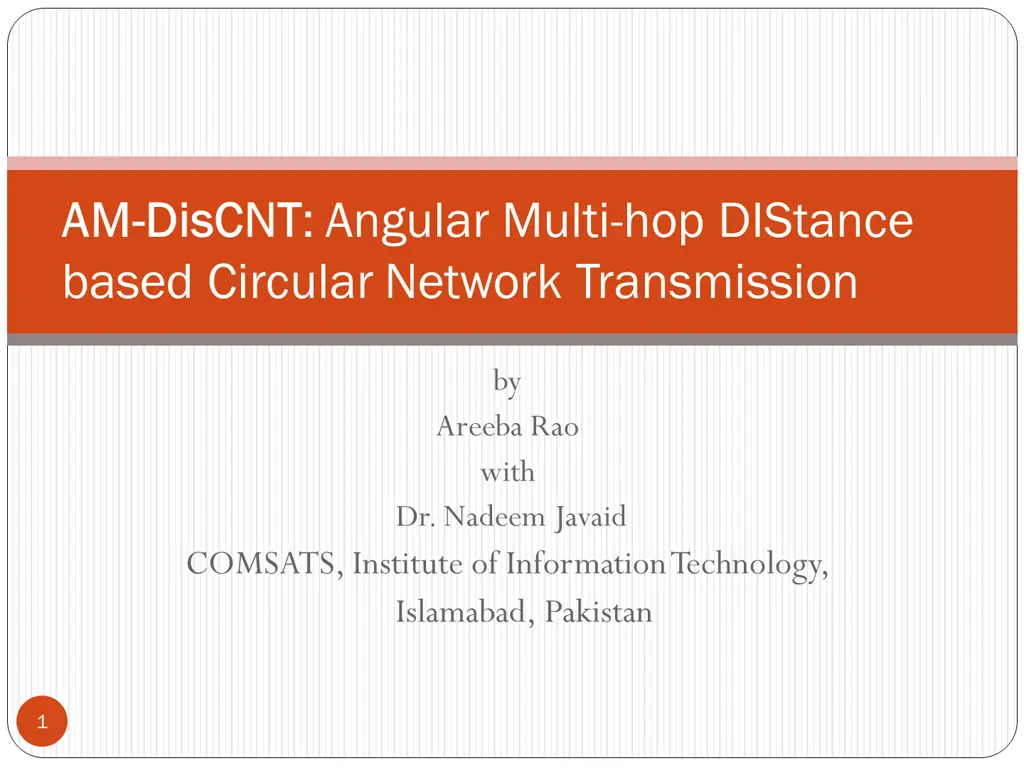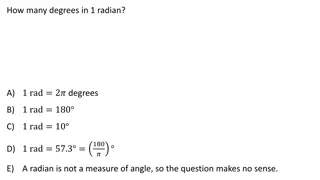AM-DisCNTDisCNT: Angular Multi-hop Distance Circular Network Transmission
An in-depth exploration of wireless sensor networks, applications, design challenges, and factors. Discusses the Low Energy Adaptive Clustering Hierarchy protocol. Includes real-world examples and informative visuals.
Download Presentation

Please find below an Image/Link to download the presentation.
The content on the website is provided AS IS for your information and personal use only. It may not be sold, licensed, or shared on other websites without obtaining consent from the author. Download presentation by click this link. If you encounter any issues during the download, it is possible that the publisher has removed the file from their server.
E N D
Presentation Transcript
AM AM- -DisCNT DisCNT: Angular Multi-hop DIStance based Circular Network Transmission by Areeba Rao with Dr. Nadeem Javaid COMSATS, Institute of Information Technology, Islamabad, Pakistan 1
Introduction Introduction Wireless Sensor Networks (WSNs): Highly distributed networks of small, lightweight wireless nodes, Deployed in large numbers, Monitors the environment or system by measuring physical parameters such as temperature, pressure, humidity. Node: sensing + processing + communication 2
Applications of WSNs Constant monitoring & detection of specific events Military, battlefield surveillance Forest fire & flood detection Habitat exploration of animals Patient monitoring Home appliances 3
Design Issues & Challenges Design Issues & Challenges Random deployment autonomous setup & maintenance Infrastructure-less networks distributed routing Energy, the major constraint trading off network lifetime for fault tolerance or accuracy of results Hardware energy efficiency Distributed synchronization Adapting to changes in connectivity Security 4
Design Factors Design Factors Scalability Fault tolerance Power consumption Sensor network architectures: Layered Clustered 5
Low Low- -Energy Adaptive Clustering Energy Adaptive Clustering Hierarchy (LEACH) Hierarchy (LEACH) Setup phase: >Each sensor chooses a random number m between 0 and 1 >If m <T(n) for node n, the node becomes a cluster-head where = P if n G 1 0 [ *mod(1/ P r )] P ( ) T n , otherwise P : the desired percentage of cluster heads r : the round number G : the set of nodes that have not been cluster heads during the last 1 / P rounds A cluster head advertises its neighbors using a CSMA MAC. Surrounding nodes decide which cluster to join based on the signal strength of these messages Cluster heads assign a TDMA schedule for their members 6
Low Low- -Energy Adaptive Clustering Energy Adaptive Clustering Hierarchy (LEACH) Hierarchy (LEACH) Steady-state phase: All source nodes send their data to their cluster heads Cluster heads perform data aggregation/fusion through local transmission Cluster heads send them back to the BS using a single direct transmission After a certain period of time, cluster heads are selected again through the set-up phase 7
SEP SEP Differentiate nodes in terms of their energy (heterogeneous) Consider two types of nodes w.r.t energy: normal and advanced nodes where: Energy of advanced nodes > Energy of normal nodes CH selection probability of advanced nodes is greater than normal nodes Use same threshold T(si) for CH selection as described by LEACH Each node is elected CH once every 1/P rounds (epoch length) Epoch of advanced nodes < epoch of normal nodes 8
DEEC DEEC Differentiate nodes in terms of their energy (heterogeneous) Consider multiple energy levels of nodes Use same threshold T(si) for CH selection as described by LEACH Epoch of high energy nodes < epoch of low energy nodes 9
DEEC DEEC DEEC uses the below probability for CH selection in multi- level heterogeneous network. DEEC estimate average energy E(r) of the network for any round r as: R denotes total rounds of network lifetime and is estimated as: Etotal is total energy of the network where Eround is energy expenditure during each round. 10
Heterogeneous WSN Model Heterogeneous WSN Model Heterogeneous WSNs contain two, three or multi types of nodes are termed as two, three and multi level heterogeneous WSNs respectively. Two level heterogeneous WSNs contain two energy level of nodes, normal and advanced nodes. Normal and advance nodes contain Eo and Eo(1 + a) energies respectively. The total initial energy of the network is the sum of energies of normal and advanced nodes. The two level heterogeneous WSNs contain am times more energy as compared to homogeneous WSNs. 11
Heterogeneous WSN Model Heterogeneous WSN Model >Three level heterogeneous WSNs contain three different energy levels of nodes i.e normal, advanced and super nodes. >Normal, advance and super nodes contain Eo, Eo(1 + a) and Eo(1 + b) energies respectively. >The total initial energy of three level heterogeneous WSN is therefore given by: >The three level heterogeneous WSNs contain (a + mob) times more energy as compared to homogeneous WSNs. 12
Heterogeneous WSN Model Heterogeneous WSN Model Multi level heterogeneous WSN is a network that contains nodes of multiple energy levels. The initial energy of nodes is distributed over the close set [Eo,Eo(1 + amax)], where Eo is the lower bound and amax is the upperbound energy. Initially, node Si is equipped with initial energy of Eo(1+ai). The total initial energy of multi-level heterogeneous networks is given by: 13
Radio Dissipation Model Radio Dissipation Model The radio energy model describes that l bit message is transmitted over a distance d, energy expended is then given by: Eelec is the energy dissipated per bit to run the transmitter or the receiver circuit. d is the distance between sender and receiver, fs is free space model and mp is multipath model is used. Now, total energy dissipated in the network during a round is given by: Where, K= number of clusters EDA= Data aggregation cost expended in CH dtoBS= Average distance between the CH and BS dtoCH= Average distance between the cluster members and the CH 14
AM AM- -DisCNT DisCNT All nodes are heterogeneous i.e. , they all nodes have different energy at the start of the network. AM-DisCNT is based on static clustering. The number of clusters are fixed and the shape and size of clusters is pre-defined. In proposed protocol, the BS is at the center of the field, i.e. , if the area of the network is R2. The total area is divided into 9 regions as shown in the following figure. 15
AM AM- -DisCNT DisCNT Schematics Schematics 16
Inner circle communication Inner circle communication The region R1 is closest to the BS and uses Direct Communication as its routing technique. In Direct Communication, every node sends its data directly to the BS. 17
Outer circle communication Outer circle communication Regions R2 to R9, do not use Direct Communication. They form CHs to send their data to the BS. Each region except R1 is called a cluster and each cluster has only one CH for a particular round. Other nodes of regions R2-R9 send their data to the BS via CH of their region. The CH is chosen on the basis of maximum energy. It means that in any round the node having the maximum energy becomes the CH. 18
Outer circle communication Outer circle communication The CHs of outer regions send their data to the nodes of inner circle. The inner circle nodes forward the received data to BS. 19
Region formation Region formation Whole network is divided into nine regions. First of all, the network is divided into two concentric circles. 20
Region formation Region formation Outer circle is further divided into eight regions. This division is done after every 45 degrees angle. 21
Region formation Region formation Each region contains fixed number of nodes. R1 contains 20 nodes, whereas, all of regions contain 10 nodes each. The BS is located at the center of the field. And the fixed number of nodes for each region is distributed randomly in that region. 22
Cluster head selection Cluster head selection Unlike LEACH and DEEC in which the CHs are selected on probabilistic basis, our proposed protocol selects a node as the CH of that region if it has the maximum energy before the start of that round. All nodes send their data to the CH which receives the data from all the nodes, aggregates it and sends it to the BS. When the first round is completed, the amount of energy in each node would not be the same. This is because the utilization of energy depends upon the distance between the node/CH which is transmitting and the CH/sink which is receiving. 23
Simulation Results Simulation Results The performance of AM-DisCNT is calculated by using MATLAB. The network parameter table is given below; 24
Performance Parameters Performance Parameters There are seven performance parameters 1. Alive nodes 2. Packets send to BS 3. Dead nodes 4. Delay 5. Throughput 6. CHs 7. Confidence interval 25
Confidence Interval Confidence Interval The confidence interval is the statistical estimate that is used to calculate the range of values that is likely to contain the data of interest. This interval is calculated using the formulae; The left side of equation gives the lower bound and right side is used to calculate the upper bound. in the above equation is given by; Here, N is the number of alive nodes. z is the averaged value. Xi are the samples of nodes(dead, alive etc). 26
Other Performance Parameters Other Performance Parameters Alive nodes: Nodes that have some residual energy and they can send their status to CH or BS are termed as alive nodes. Network throughput: Throughput of the network is the number of data packets that are send to base-station. Confidence interval: It is used to indicate the reliability and authentication of estimated results. Packets received: Packets received refers to the number of packets received at the BS. Delay: The time consumed by the packet to reach the specified destination is termed as delay. 27
Alive Nodes Alive Nodes The lifetime of a network depends upon the number of alive nodes. As long as there is even one alive node in the network, its lifetime counts. So the lifetime of a network refers to the time period from the start of the network till the death of the last node. The following figure shows the Confidence Interval of alive nodes: 28
Dead Nodes Dead Nodes The graph of dead nodes compared with DEEC and LEACH is as follows; 29
No. of Packets Received No. of Packets Received The average packets received at the sink in LEACH are less as compared to our protocol but these are almost equal to DEEC as shown in figure shown below: 30
Packets sent to BS Packets sent to BS The average packets sent to the sink in LEACH and DEEC are less as compared to our protocol as shown in figure shown below: 31
Packets sent to BS Packets sent to BS It can be seen that the average packets sent to the sink in LEACH and DEEC are less as compared to our protocol as shown in the figure. This is because in LEACH and DEEC on average, there would be around 10 t CHs (not always exactly 10) in a round. And we know that the normal nodes do not send their data directly to the sink. Instead, they send their data to the BS via the CH. So on an average, there would be around 10 packets sent per round. Whereas in our Protocol, 20 nodes are present in the region R1 which is closest to the sink and they send their data directly to the sink. In all the other 8 regions, 8 nodes would be CHs in each round. 32
No. of CHs No. of CHs The figure shows that the CHs of LEACH and DEEC are not fixed rather they vary over the interval. Whereas, the CHs of AM-DisCNT are fixed upto 2000thround. 33
Delay Delay Delay of a packet to reach BS is measured and compared with DEEC and LEACH. The figure shows that the delay of AM- DisCNT is least. This is because the inner circle uses direct communication. 34
Conclusion Conclusion Our proposed technique uses static clustering and CHs are selected on the basis of the maximum energy of the nodes. AM-DisCNT is more efficient than LEACH and DEEC in terms of network lifetime, stability, area coverage, energy efficiency and throughput. This results in fixed number of CHs in each round as well as the optimum number of CHs is also maintained. We implemented Packet Drop Model to make our protocol more practical. We also implemented Confidence Interval to find the possible deviation of our graphs from the mean value, where mean value is calculated by simulating our protocol 5 times and then taking its mean. This scheme enhances the desired attributes, i.e., minimum energy consumption, maximum stability period, better lifetime and throughput allot as compared with LEACH. 35






















